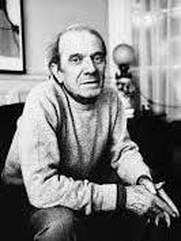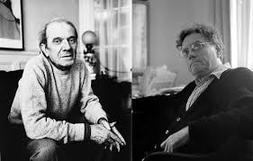Gilles Deleuze
Contents:
- On Gilles Deleuze
- On "How do we Recognize Structuralism?"
On Gilles Deleuze (Paris, 1925-1995):
Sorbonne educated contemporary French postmodernist philosopher who taught at Paris VII (1969-87) and was known for innovative (infamous) collaborative (with Félix Guattari) two-volume ‘Capitalism and Schizophrenia’ project of Anti-Oedipus and A Thousand Plateaus (politically active and a close friend of Michel Foucault, these were said to be seminal expressions of the France’s May 1968 political climate), as well as radical readings of canonical figures (Hume, Kant, Leibniz, Spinoza, Nietzsche, etc.) and aesthetic topics and figures (film, painter Francis Bacon, Kafka, Marquis de Sade, Proust, etc.), all thoroughly cross-disciplinary and highlighted by ideas of intensity (immanence as ‘flux of existence’ that has no transcendental outside and is driven by forces), difference and repetition (as temporality without identity; analysis must proceed not by essence but by structural relations, yet rejection of Hegelian dialectic), and becoming (versus being; and command for creativity yet with demotion of human subject).
Sorbonne educated contemporary French postmodernist philosopher who taught at Paris VII (1969-87) and was known for innovative (infamous) collaborative (with Félix Guattari) two-volume ‘Capitalism and Schizophrenia’ project of Anti-Oedipus and A Thousand Plateaus (politically active and a close friend of Michel Foucault, these were said to be seminal expressions of the France’s May 1968 political climate), as well as radical readings of canonical figures (Hume, Kant, Leibniz, Spinoza, Nietzsche, etc.) and aesthetic topics and figures (film, painter Francis Bacon, Kafka, Marquis de Sade, Proust, etc.), all thoroughly cross-disciplinary and highlighted by ideas of intensity (immanence as ‘flux of existence’ that has no transcendental outside and is driven by forces), difference and repetition (as temporality without identity; analysis must proceed not by essence but by structural relations, yet rejection of Hegelian dialectic), and becoming (versus being; and command for creativity yet with demotion of human subject).
“Not just the real and the imaginary, but their relations, and the disturbances of these relations, must be thought as the limit of a process in which they constitute themselves in relation to the symbolic. ... the symbolic as element of the structure constitutes the principle of a genesis: structure is incarnated in realities and images according to determinable series. Moreover, the structure constitutes series by incarnating itself, but is not derived from them since it is deeper, being the substratum both for the strata of the real and for the heights of imagination.” |
Deleuze, “How do we Recognize Structuralism?”
Gilles Deleuze, “How do we Recognize Structuralism?,”
in Desert Islands: and Other Texts, 1953-1974 (Cambridge, MA: Semiotext(e), 2004), 170-92.
. . . & in M O R E D E T A I L . . .
How is the symbolic a structural object?
“Not just the real and the imaginary, but their relations, and the disturbances of these relations, must be thought as the limit of a process in which they constitute themselves in relation to the symbolic. … the symbolic as element of the structure constitutes the principle of a genesis: structure is incarnated in realities and images according to determinable series. Moreover, the structure constitutes series by incarnating itself, but is not derived from them since it is deeper, being the substratum both for the strata of the real and for the heights of imagination” (172).
in Desert Islands: and Other Texts, 1953-1974 (Cambridge, MA: Semiotext(e), 2004), 170-92.
- The Essay's 7 Criteria:
- 1st Criterion: The Symbolic
- 2nd: Local or Positional
- 3rd: The Differential and The Singular
- 4th: The Differenciator, Differentiation
- 5th: Serial
- 6th: The Empty Square (la case vide)
- 7th: From The Subject to Practice
- 1st Criterion: The Symbolic
- Real vs. Imaginary vs. Symbolic
- How is the symbolic a structural object?
- 2nd: Local or Positional
- What’s in the symbolic element?
- Sens [excess] as positional [games] in topological space [site over subject]
- 3rd: The Differential and The Singular
- Elements {phomenes … singularities … functions}
- &
- Relations {structures as multiplicities … differentials … variables}
- 4th: The Differenciator, Differentiation
- Virtualities
- Whole not total, but is
- Time
- Unconscious
- 5th: Serial
- Homology of two+ series à contradictions
- Slippage
- Metaphors and Metonymy
- 6th: The Empty Square (la case vide)
- Petit objet x
- Required for games
- Phallus
- Structural Orders
- 7th: From The Subject to Practice
- Void
- Subject as subjected to empty square {à nomad}
. . . & in M O R E D E T A I L . . .
- 1st Criterion: The Symbolic … “The refusal to confuse the symbolic with the imaginary, as much as with the real, constitutes the first dimension of structuralism” (171).
- ... SEE notes on Jacques Lacan for some more background ...
- Real vs. Imaginary vs. Symbolic
- Real: “the real in itself is not separable from a certain ideal of unification or of totalization: the real tends towards one, it is one in its ‘truth’” (172)
- Imaginary: “As soon as we see two in ‘one,’ as soon as we make doubles, the imaginary appears in person, even if it is in the real that its action is carried out. … The imaginary is always defined by games of mirroring, of duplication, of reversed identification and projection, always in the mode of the double” (172)
- Symbolic: “the symbol is three, and not merely the third beyond the real and the imaginary. There is always a third to be sought in the symbolic itself; structure is at least triadic, without which it would not ‘circulate’—a third at once unreal, and yet not imaginable” (172).
- The symbolic order is “irreducible to the orders of the real and the imaginary, and deeper than they are” (173); it …
- Real vs. Imaginary vs. Symbolic
- Form
- “for structure is not at all defined by an autonomy of the whole, by a preeminence of the whole over its parts, by a Gestalt which would operate in the real and in perception” (173)
- Instead:
“Structure is defined, on the contrary, by the nature of certain atomic elements which claim to account both for the formation of wholes and for the variation of their parts” (173)
- Instead:
- Figures
- “nothing to do with figures of the imagination” (173)
- Instead:
“although structuralism is riddled with reflections on metaphor and metonymy, for these figures themselves imply structural displacements which must account for both the literal and the figurative” (173)
- Instead:
- Essence
- “Nor has it anything to do with an essence” (173)
- Instead:
“it is more a combinatory formula supporting formal elements which by themselves have neither form, nor signification, nor representation, nor content, nor given empirical reality, nor hypothetical functional model, nor intelligibility behind appearances” (173)
- Instead:
How is the symbolic a structural object?
“Not just the real and the imaginary, but their relations, and the disturbances of these relations, must be thought as the limit of a process in which they constitute themselves in relation to the symbolic. … the symbolic as element of the structure constitutes the principle of a genesis: structure is incarnated in realities and images according to determinable series. Moreover, the structure constitutes series by incarnating itself, but is not derived from them since it is deeper, being the substratum both for the strata of the real and for the heights of imagination” (172).
"The two of us wrote Anti-Oedipus together. Since each of us was several, there was already quite a crowd. Here [in Thousand Plateaus] we have made use of everything that came within range, what was closest as well as farthest away. We have assigned clever pseudonyms to prevent recognition. Why have we kept our own names? Out of habit, purely out of habit. To make ourselves unrecognizable in turn. To render imperceptible, not ourselves, but what makes us act, feel, and thing. Also because it's nice to talk like everybody else, to say the sun rises, when everybody knows it's only a manner of speaking. To reach, not the point where one no longer says I, but the point where it is no longer of any importance whether one says I. We are no longer ourselves. Each will know his own. We have been aided, inspired, multiplied."" |
...
Site powered by Weebly. Managed by MacHighway

